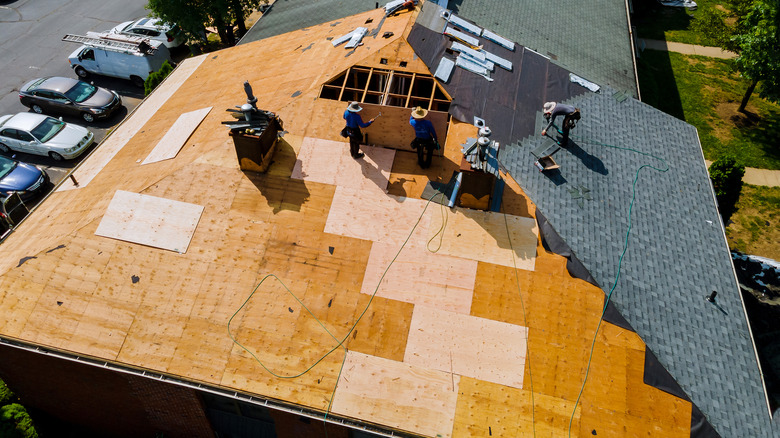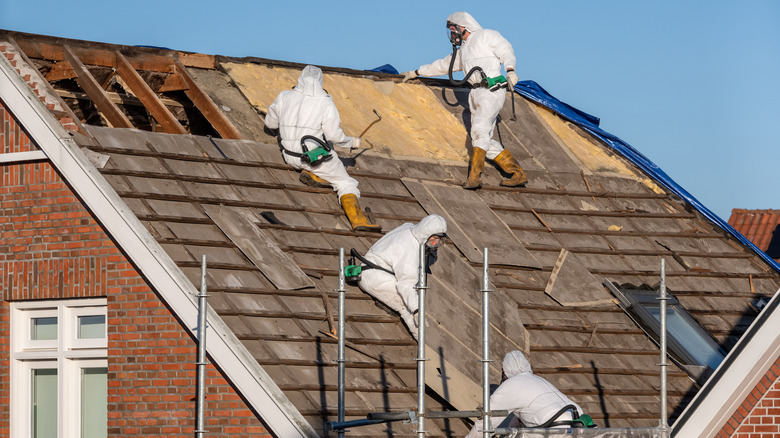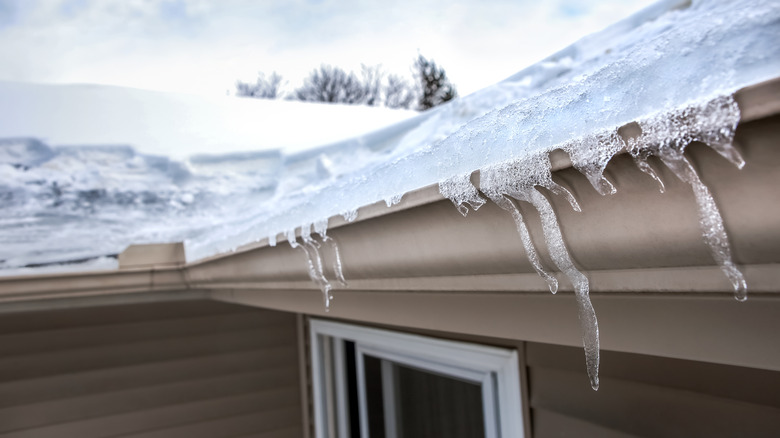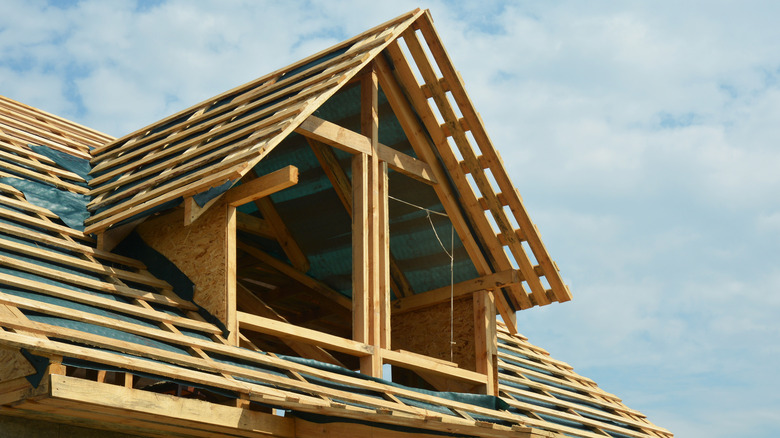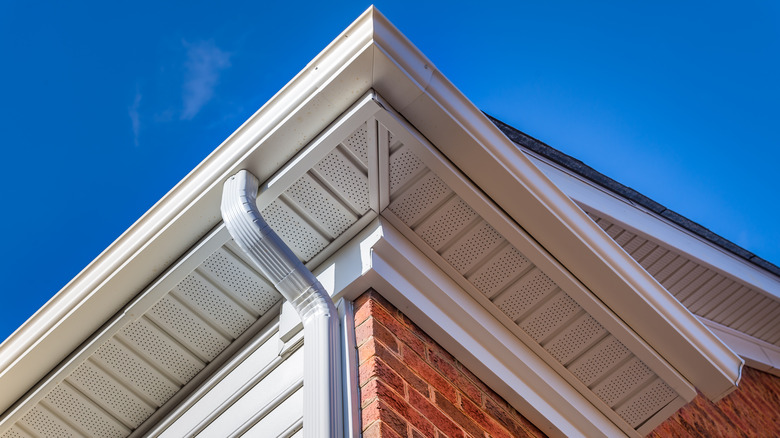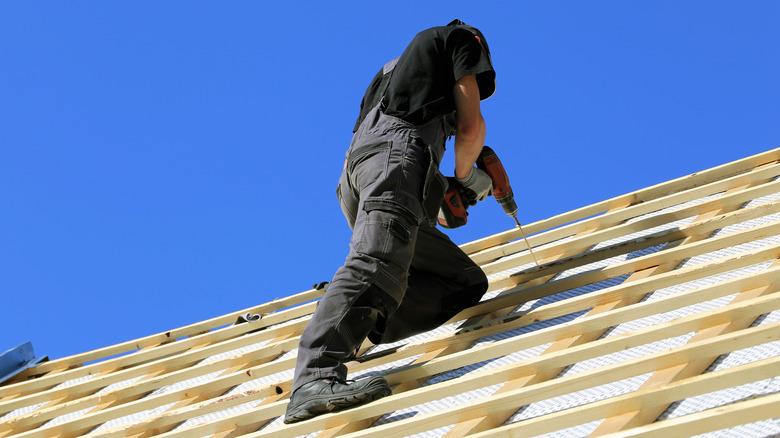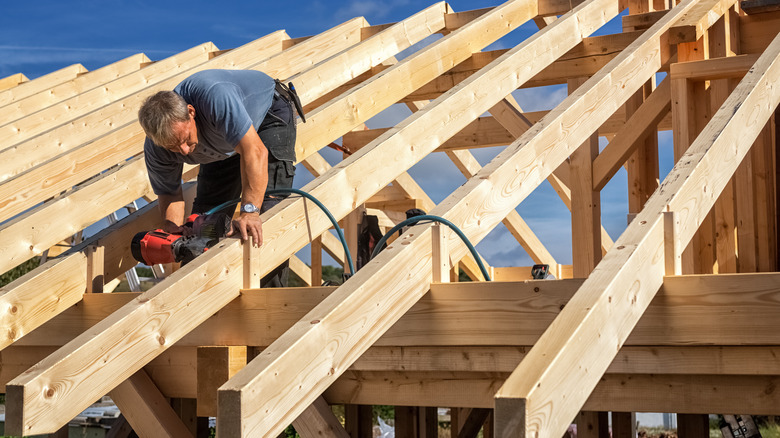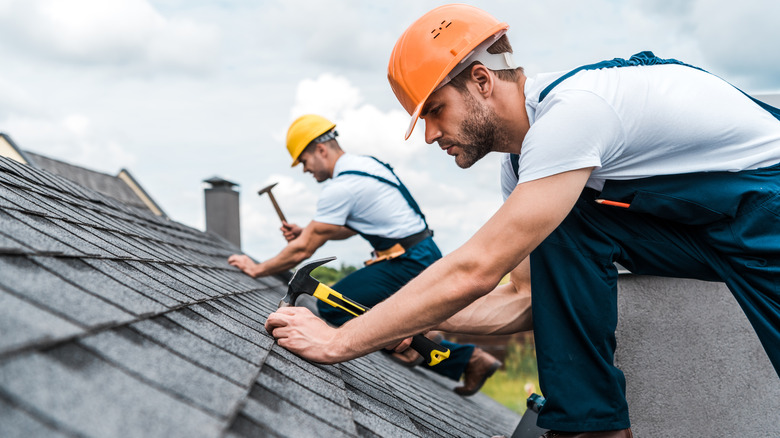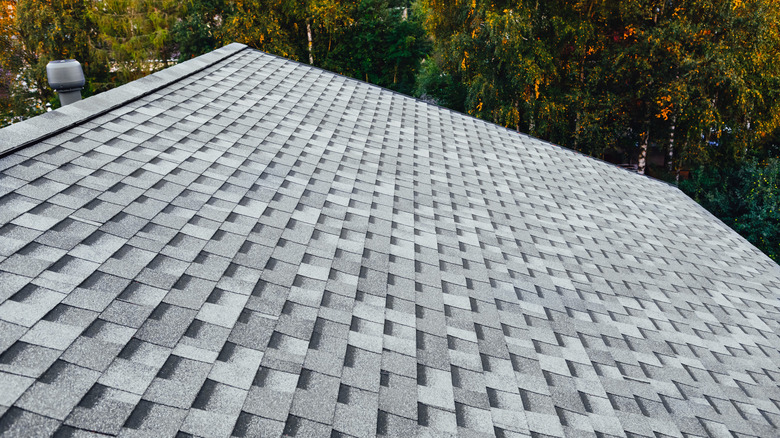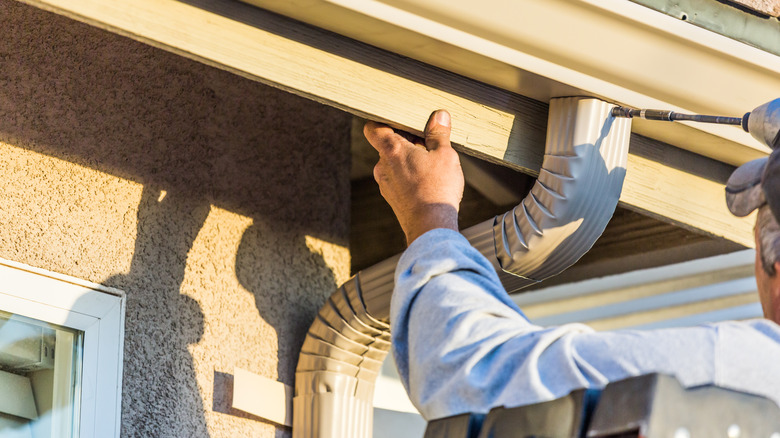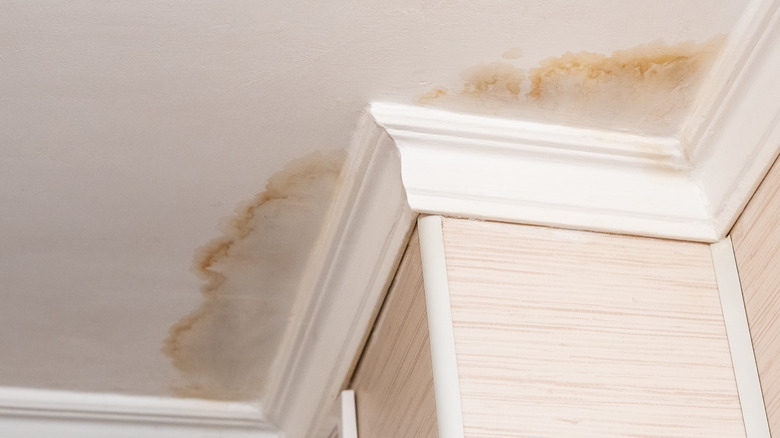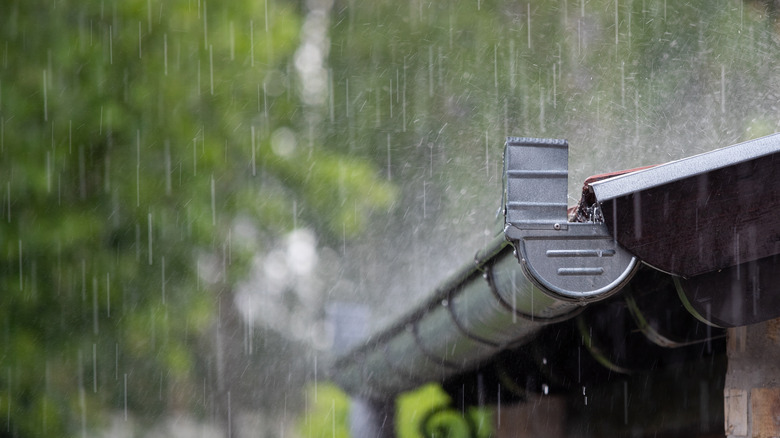Mistakes Everyone Makes When Getting A New Roof
Replacing your roof is an essential part of being a homeowner. According to Bob Vila, the signs of needing a new roof are pretty obvious, even to those who don't have much experience in construction. When it's time, you'll notice that the shingles on your roof are starting to look a little bit worse for the wear. They will be faded, torn, or even cracked in some places. In addition, your roof might start to look like it's sagging, which is a telltale sign of roof rot. You might have moss or other plant life growing on your roof. If your roof is already at this point, it's time to call up a contractor or make plans to replace it yourself.
However, a great way to keep your home healthy and rescue your roof before it gets to an unattractive stage is to keep track of the replacement date. From there, you can set up a replacement schedule. You should get a new roof every 25-30 years, barring damage like a big storm (via Bill Ragan Roofing). When you purchased your home, your home inspector should have given this information to you. However, there are some things you should keep in mind once you know it's time to get a new roof. Whether you're buying a slate or metal roof, there are plenty of tips to keep in mind. As long as you avoid these common mistakes, you and your new roof should be in tip-top shape.
Forgetting to remove the old shingles
One typical mistake homeowners make when getting a new roof is forgetting to remove the old shingles before beginning work. Yes, removing every shingle is essential if you don't want to set yourself back in your roofing work. According to This Old House, it's easy to spot the shingles that need replacing. If they are discolored, curling up on the sides or end, or cracked, you need to get rid of them.
While it can cost up to $3,000 to demolish your old roof before starting fresh, you can also choose to do it yourself to cut down on costs (via Budget Dumpster). You will need to ensure that if you are working with a contractor to install the new shingles, it's that same day or soon after. This way, your bare roof won't become damaged. By removing all the old, damaged shingles, you save yourself the hassle of having to do a patch job in the future.
Purchasing supplies from different sources
If you don't plan when it's time to get a new roof, you may have a patchy and mismatched result. According to DryHome, roof shingles can, unfortunately, change appearance over time. The constant sunlight, rain, hail, and wind can cause individual shingles and large groups to fade and warp over the years.
In addition to environmental damage, there is another problem. When shopping for shingles, you'll find that different suppliers carry different brands. If you run out of shingles halfway through the re-roofing process or need to replace a few spots on your roof, you will have to find new ones that might not match perfectly. To ensure a consistent result, buy your shingles from one source. It is always better to have a few too many shingles left over to use for patch jobs than it is to run out halfway through the process and scramble to find what you need to finish the project.
Skipping the ice and water shield
Don't skip the ice and water shields when you get a new roof. Even if you don't live somewhere with lots of ice, these safeguards will protect your roof long term. According to Bone Dry Roofing, roofers tend to use them in multiple locations for maximum impact. You'll find them along the house eaves to prevent leaks from seeping inside. Next, you'll find protection in the valleys of your home's roof, which is the part of the structure where two slopes meet. The water forms and freezes on the shield instead of on your roof. There is less chance of it seeping through this way. Finally, you'll see them placed around chimneys.
Ice and water shield maintenance is essential as it plays a crucial role in protecting your roof (and walls, ceilings, etc.) from water damage (via Kerrigan Roofing). It's much easier to monitor the ice and water shields and repair them as needed than to replace an entire roof or fix a leak, no matter the size.
Forgetting to leave room to ventilate the attic
When sealing up your new roof, it's normal to want to make things as watertight as possible. However, making your attic too stuffy can lead to problems in your home. You want to ventilate the space properly when getting a new roof. According to Bob Vila, doing things this way might sound counterintuitive. After all, won't you be paying a higher energy bill each month with all that air leaking out of your attic? However, that's not the case. A well-ventilated attic saves you money in the long run.
Attics sealed off from the outside trap heat and moisture hostage in warm climates, which leads to shingles warping and cracking (via Roofing Contractor). During the winter, this trapped moisture can also freeze and ruin shingles. To avoid this, you'll need to work with your contractor (or yourself) to ensure that your attic has a great system of intake and exhaust vents and, in some cases, fans to keep things aerated. You'll also want to check out how much it costs to insulate an attic.
Incorrectly installing overhangs
When getting a new roof, a crucial mistake to avoid is incorrectly installing your overhangs. Overhangs need to be put together correctly for the safety of your roof and your home. According to Semper West, an overhang is the part of the roof that peeks out over the edge and provides shelter for the siding. They help keep your home safe from the heavy wind and rain, reduce glare, provide shade, and add a pop of unique personality. Most homes feature an overhang, although the length varies according to the specific architectural style.
However, while some overhang is perfect for these purposes, too much overhang can cause problems. Your shingles can blow away during adverse weather instead of protecting your home. To avoid this, work with your contractor to determine a precise measurement that keeps your home safe from damage without putting your eaves in harm's way.
Ignoring the slope of the roof
Experts in the roofing industry want to share a little secret: the slope of your roof has a significant impact on cost. According to Erie Home, the number one reason higher pitches cost more than their lower counterparts is height. When you add a steep slope, roofers automatically have to compensate with increased safety precautions. This step raises the overall bill of the project.
When selecting a roofer, choose a team with an extensive portfolio of steeply-pitched roofs under their belt (via Werner Roofing). Since this type of roofing is highly specialized, you want to make sure you get someone with the right experience so that things go according to plan. The contractor you choose will also need to be insured and hold relevant safety certificates required in your area. This way, you can ensure that you get a beautiful new roof and will avoid any potential on-site accidents along the way.
Being careless with nail placement and type
Being careless with nails is a small mistake that can lead to structural issues on your new roof. According to Roof Hub, galvanized steel is the preferred type of nail to use on roofing projects. If this roofing material is within your budget, it's best to opt for this. However, some roofers choose to use aluminum or stainless steel nails since these options also provide an acceptable amount of safety and coverage for your roof. However, the material isn't everything. When choosing your nail types, pay attention to the shape, length, and even the shank, the long and pointy part of the nail. For best results, the shank should be swirled and grooved.
When installing your roof, ensure that your nails are not exposed, save for the last row (via IKO). The attachment point should be underneath the shingle above. If exposed, they will rot away much faster and leave your home vulnerable to damage from the elements.
Adding roofing layers in the wrong order
You should install your roofing in a particular order to maintain safety. According to Sheegog Contracting, there are three roof layers to replace when updating things. The first is the roof deck. This area is the layer of plywood underneath your roof's shingles. Typically, this deck doesn't need replacing each time you change the shingles. However, it's essential to check for rotting, warping, and other potential damage while it's bare. If all is okay, you can proceed to the next step.
The area between the roof deck and the shingles is a layer that often goes overlooked. It's the metal flashing. This area is the part of your roof that protects everything from moisture damage. When replacing your shingles, it's a good idea to go ahead and replace these too. If they fail, you are in for some expensive roof repairs and the inside of your home as well. However, it's important to remember that the metal flashing goes underneath the shingles ... in some shoddy situations, contractors might try to add protection after shingle installation. In this case, it's unlikely to work at all.
Forgetting a roofing permit
Getting a new roof isn't something you can decide to do on a whim. There are plenty of due-diligence steps you will need to complete before you get started. This process typically involves a lot of paperwork. The first step is getting a permit to reroof your home. According to Eagle Watch Roofing, if you are replacing a few shingles on your home, you can likely do this without a permit since the work is not considered structural in most localities. However, as soon as you start ripping off the entire roof, your work will be structural, and you'll need a permit to proceed.
If you plan on doing the work yourself, you can apply for the permit and get started. However, if you're hiring contractors to replace your roof, their team will need to request the paperwork. A fun fact about building permits is they protect you against working with unlicensed, uninsured contractors. The issuing body (typically the county) will not issue paperwork to contractors without a license. Once you have the valid authorization, keep in mind that there is still one body you might need to gain approval from, depending on where you live: your homeowner's association or HOA.
Mislaying the starter shingles
You can save yourself a lot of time by using starter strips of shingles on your new roof. According to Digital Roofing Company, it doesn't matter what color your starter strip is. The strip will end up underneath your actual shingles after installation is complete. They are typically made of fiberglass and come in a rectangular shape. Since starter shingle strips effectively seal things off, they add extra protection to your roof against moisture, wind, water leaks, and other elements.
In addition to protection, these starter strips also offer homeowners a sleek and chic look for their roof once construction is over (via GAF). They tend to lie flatter than hand-cut shingles put together in a makeshift strip. They also benefit you during the job because they generate less waste than traditional shingles. There won't be too much waste in your yard during the roof replacement project.
Neglecting the roof's gutters
Gutters are essential to the overall health of your roof. According to GutterMaid, gutters collect rainwater and direct it to the ground. This process protects your roof and the rest of your home from sustained water damage. Without gutters, most basements would flood, and foundations would suffer water damage. Properly maintaining your gutters is key to the success of your roof and the rest of your home. Keep them free of dirt, leaves, and other outdoor debris that run off your roof with rainwater.
Gutters are an essential component of your roof (via Bob Vila). Properly maintaining them will help your home avoid ice dams and the large repair bill that comes from fixing up their fallout. Ice dams are sheets of ice formed by trapped water. Constantly melting and freezing, they ruin your shingles and can cause severe water damage to your roof. To avoid them, clean your gutters a minimum of twice a year in the spring and the fall. Be sure to avoid common gutter cleaning mistakes.
Not working with a licensed and insured contractor
When it comes time to replace your roof, don't leave yourself vulnerable to fraud and shoddy work by choosing an unlicensed contractor. According to Schorr Law, there are three main reasons to hire a licensed team. You can guarantee that they have the work ethic and the base skill level necessary for a legal permit. You can also be sure that the contractor is at least aware of local construction laws and building codes, so it's more likely that they will follow them. Finally, they are more likely to be a trustworthy partner in redoing your roof because they operate a legal business.
You might think it's easier and cheaper to have your cousin or a friend of a friend do the work for you, but if you want professional, on-time results, then it's best to go with an actual professional (via Ultimate Construction).
Waiting too long for a new roof
If you delay roof repairs, you could be placing yourself in danger. According to Sheegog Contracting, several things can go wrong, and not all are simply about aesthetics. One of the biggest concerns with ignoring an aging roof is leaving yourself vulnerable to a large leak ... one that is large enough to ruin an entire room's worth of belongings. You are also putting yourself at risk of experiencing an even greater liability should a storm roll around. Older roofs, or roofs that have already sustained damage, have the highest risk of failure.
Finally, you might even be at risk of experiencing a complete roof cave-in, depending on the state of your roof. This event is a dangerous occurrence, especially if you are at home. As your home ages, you have to weigh the maintenance costs against the cost of a complete replacement. Keep in mind that most roofs need to be replaced every 25 to 30 years, on average (via Roof Advisor).
Not planning installation according to the weather
The weather has a significant impact on your roof's health. A major storm can cause you to replace a 30-year-old roof in half the time due to the wear and tear on the shingles. This fact applies if you live in an area with heavy snowfalls. According to Golden Group Roofing, snow and ice can put excess weight on your roof and add moisture under your shingles. During the summertime, sunlight baking your roof every day can cause shingle discoloration. Plus, UV rays can cause them to expand and shrink.
While the weather impacts the longevity and looks of your home's roof, you also need to pay special attention to the weather forecast when you plan your roof replacement. When you pull off the shingles, your roof's delicate underbelly becomes exposed to the elements. To avoid damage to the structure, you'll want to get the new shingles onto your home as quickly as possible.

